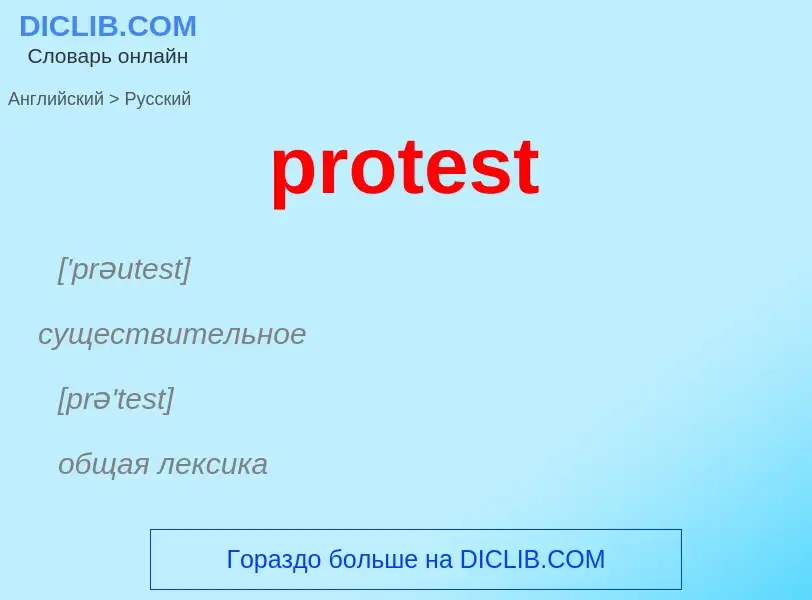Перевод и анализ слов искусственным интеллектом ChatGPT
На этой странице Вы можете получить подробный анализ слова или словосочетания, произведенный с помощью лучшей на сегодняшний день технологии искусственного интеллекта:
- как употребляется слово
- частота употребления
- используется оно чаще в устной или письменной речи
- варианты перевода слова
- примеры употребления (несколько фраз с переводом)
- этимология
protest - перевод на русский
['prəutest]
существительное
[prə'test]
общая лексика
протест
возражение
финансы
опротестование (векселя)
протест (по векселю)
опротестование, протест (векселя)
коммерция
морской протест
юриспруденция
торжественное заявление
глагол
общая лексика
протестовать
возражать
торжественно заявлять
утверждать
протестовать, возражать
заявлять протест
финансы
опротестовывать (вексель)
совершить
учинить протест (по векселю)
опротестовывать (вексель)
разговорное выражение
уверять
устаревшее выражение
уверять, говорить
2) протест, опротестование (векселя) || опротестовывать (вексель)
3) морской [судовой] протест
- protest by master
- protest for nonacceptance
- protest for nonpayment
- protest in due course
- no protest
- enter a protest
- lodge a protest
- make a protest
- note a protest
- due protest
- past due protest
Определение
Википедия

A protest (also called a demonstration, remonstration or remonstrance or a maree richo) is a public expression of objection, disapproval or dissent towards an idea or action, typically a political one. Protests can be thought of as acts of cooperation in which numerous people cooperate by attending, and share the potential costs and risks of doing so. Protests can take many different forms, from individual statements to mass demonstrations. Protesters may organize a protest as a way of publicly making their opinions heard in an attempt to influence public opinion or government policy, or they may undertake direct action in an attempt to enact desired changes themselves. Where protests are part of a systematic and peaceful nonviolent campaign to achieve a particular objective, and involve the use of pressure as well as persuasion, they go beyond mere protest and may be better described as a type of protest called civil resistance or nonviolent resistance.
Various forms of self-expression and protest are sometimes restricted by governmental policy (such as the requirement of protest permits), economic circumstances, religious orthodoxy, social structures, or media monopoly. One state reaction to protests is the use of riot police. Observers have noted an increased militarization of protest policing in many countries, with police deploying armored vehicles and snipers against protesters. When such restrictions occur, protests may assume the form of open civil disobedience, more subtle forms of resistance against the restrictions, or may spill over into other areas such as culture and emigration.
A protest itself may at times be the subject of a counter-protest. In such cases, counter-protesters demonstrate their support for the person, policy, action, etc. that is the subject of the original protest. Protesters and counter-protesters can sometimes violently clash. One study found that nonviolent activism during the civil rights movement in the United States tended to produce favorable media coverage and changes in public opinion focusing on the issues organizers were raising, but violent protests tended to generate unfavorable media coverage that generated public desire to restore law and order.


![Protesters against [[big government]] fill the West Lawn of the [[U.S. Capitol]] and the [[National Mall]], 12 September 2009 Protesters against [[big government]] fill the West Lawn of the [[U.S. Capitol]] and the [[National Mall]], 12 September 2009](https://commons.wikimedia.org/wiki/Special:FilePath/9.12 tea party in DC.jpg?width=200)

![brutal polices]] during referendum brutal polices]] during referendum](https://commons.wikimedia.org/wiki/Special:FilePath/Demonstration in front of the headquarters of the Spanish National Police in Barcelona.png?width=200)
![Protest inside the [[Wisconsin State Capitol]] Protest inside the [[Wisconsin State Capitol]]](https://commons.wikimedia.org/wiki/Special:FilePath/Gov Walker Protests1 JR.jpg?width=200)
![Farmer land rights protest in [[Jakarta]], Indonesia Farmer land rights protest in [[Jakarta]], Indonesia](https://commons.wikimedia.org/wiki/Special:FilePath/Jakarta farmers protest14.jpg?width=200)

![Iraq War Protest]] in [[Washington, D.C.]]<ref>[https://www.flickr.com/photos/7563356@N08/3377938160/ https://www.flickr.com] Image of black bloc members during an Iraq War protest in Washington, D.C., 21 March 2009</ref> Iraq War Protest]] in [[Washington, D.C.]]<ref>[https://www.flickr.com/photos/7563356@N08/3377938160/ https://www.flickr.com] Image of black bloc members during an Iraq War protest in Washington, D.C., 21 March 2009</ref>](https://commons.wikimedia.org/wiki/Special:FilePath/M2109 Iraq War Protest (Black Bloc Element).jpg?width=200)
![March next to the [[Benito Juárez Hemicycle]], 27 August 1968, [[Mexico City]] March next to the [[Benito Juárez Hemicycle]], 27 August 1968, [[Mexico City]]](https://commons.wikimedia.org/wiki/Special:FilePath/Manifestació 27 d'agost.jpg?width=200)
![Debanhi Escobar]]. Debanhi Escobar]].](https://commons.wikimedia.org/wiki/Special:FilePath/No murió, La mataron. Cartel en la marcha por la desaparición de Debahni Escobar.jpg?width=200)
![Protesters outside the [[Oireachtas]] in [[Dublin]], [[Republic of Ireland]] Protesters outside the [[Oireachtas]] in [[Dublin]], [[Republic of Ireland]]](https://commons.wikimedia.org/wiki/Special:FilePath/Occupy the Dáil - We are the 99 per cent.jpg?width=200)
![TET passed candidates who are protesting over SSC scam in [[West Bengal]], beneath the statue of [[Mahatma Gandhi]] in [[Kolkata]] Maidan. TET passed candidates who are protesting over SSC scam in [[West Bengal]], beneath the statue of [[Mahatma Gandhi]] in [[Kolkata]] Maidan.](https://commons.wikimedia.org/wiki/Special:FilePath/Protest over TET, SSC education scam in West Bengal 01.jpg?width=200)
![Demonstration in front of the [[MPR/DPR/DPD building]] in [[Jakarta]] during [[2019 Indonesian protests and riots]] Demonstration in front of the [[MPR/DPR/DPD building]] in [[Jakarta]] during [[2019 Indonesian protests and riots]]](https://commons.wikimedia.org/wiki/Special:FilePath/September2019jakartademo2.jpg?width=200)
![Protester with a "Free The Bee" placard during the COVID-19 protests in Berlin on 29th of August 2020, near the [[Brandenburg Gate]] Protester with a "Free The Bee" placard during the COVID-19 protests in Berlin on 29th of August 2020, near the [[Brandenburg Gate]]](https://commons.wikimedia.org/wiki/Special:FilePath/Vicent-van-Volkmer-Bienen-Aktivist-Demo-29.08.2020 Berlin Covid-19 Pandemie.jpg?width=200)
![special status]]. special status]].](https://commons.wikimedia.org/wiki/Special:FilePath/Washington, D.C. license plate, 2013.jpg?width=200)
![Russia invaded Ukraine]] in February 2022 Russia invaded Ukraine]] in February 2022](https://commons.wikimedia.org/wiki/Special:FilePath/We Stand with Ukraine 2022 Helsinki - Finland (51905533738).jpg?width=200)
